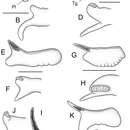Comprehensive Description
provided by Smithsonian Contributions to Zoology
Pyrgulopsis micrococcus (Pilsbry, 1893)
Amnicola micrococcus Pilsbry in Stearns, 1893:277, fig. 1.—Pilsbry, 1899:121 [in part].—Stearns, 1901:286 [in part; fig. 4].—Hannibal, 1912a:38; 1912b:185.—Walker, 1918:134.—Baker, 1964:174.—Richardson et al., 1991:64.
Fontelicella (Microamnicola) micrococcus.—Gregg and Taylor, 1965:109.—Burch, 1982:26, figs. 231, 244.
Fontelicella micrococcus.—Taylor, 1975:123.—Turgeon et al., 1988:61.
Pyrgulopsis micrococcus.—Hershler and Thompson, 1987:29, figs. 7, 33.—Hershler and Sada, 1987:788, figs. 8a, 9–16).—Hershler, 1989:182, figs. 17c,d, 20–25.—Hershler and Pratt, 1990:285, fig. 5.—USDI, 1991b:58818.
Paludestrina stearnsiana.—Berry, 1909:78.
Amnicola stearnsiana.—Berry, 1948:59.
Paludestrina longinqua.—Hannibal, 1912a:34 [in part].
Hydrobia sp.—Taylor, 1954:69.
DIAGNOSIS.—Shell globose to ovate-conic, small to medium-sized, umbilicate. Penial filament medium length, lobe short. Penial ornament a variably shaped terminal gland.
DESCRIPTION.—Shell (Figure 20a) globose to ovate-conic; height, 1.1–3.1 mm, whorls, 3.25–3.5. Protoconch weakly punctate adapically, becoming smoother toward beginning of teleoconch; later portion with a few weak spiral lines adapically. Teleoconch whorls convex, slightly shouldered; sculpture of moderately strong growth lines. Aperture usually slightly separated from body whorl. Inner lip complete, slightly thickened; columellar lip slightly reflected. Outer lip near orthocline. Umbilicus rimate-perforate. Periostracum light brown.
Operculum (Figure 20b,c) ovate, light amber; nucleus slightly eccentric; dorsal surface weakly frilled. Attachment scar margin slightly thickened between nucleus and mid-point of inner edge; callus small.
Central radular tooth (Figure 37d) with moderately indented dorsal edge; lateral cusps, 4–7; central cusp pointed, slightly broader and longer than laterals; basal cusps, 1, medium-sized, with weak dorsal support. Basal process narrow; basal sockets deep. Lateral margins thickened; neck pronounced.
Cephalic tentacles pale or with small patch of gray-black pigment just distal to eyespots. Snout pale to dark gray-black. Foot pale to black; pigment often especially strong along anterior edge. Opercular lobe pale or black along anterior edge. Neck pale to dark gray-black. Pallial roof, visceral coil moderate to dark gray-black.
Ctenidial filaments, 17, medium height, narrow. Osphradium centered slightly posterior to middle of ctenidial axis. Kidney opening thickened, sometimes white. Stomach caecum small, broad.
Testis, 1.0–1.5 whorls, overlapping anterior stomach chamber almost to posterior edge of style sac. Prostate gland a fat bean-shape, with medium-large (20%–33%) pallial section; pallial vas deferens with proximal kink. Penis (Figure 48d) medium-sized; filament medium length, narrow, tapered; lobe usually short, squat, rounded distally. Terminal gland medium-sized (sometimes reduced-absent), circular-horizontal, borne along ventral surface of distal edge of lobe. Filament dark.
Female genitalia shown in Figure 5e. Ovary, 0.5–0.75 whorl, slightly overlapping posterior stomach chamber. Albumen gland without a pallial section. Capsule gland shorter than albumen gland. Genital aperture a subterminal slit with short vestibule. Coiled oviduct a slight horizontal twist followed by broad horizontal loop (often kinked in middle), positioned well behind pallial wall. Oviduct and bursal duct join just behind pallial wall. Bursa copulatrix ovoid, medium length and width, with up to half of length posterior to gland. Bursal duct moderately broad, medium length. Seminal receptacle pouchlike, short, partly overlapping (or slightly lateral to) anterior bursa copulatrix.
TYPE LOCALITY.—Small spring in Oasis Valley [Nye County], Nevada. Lectotype (Baker, 1964:174), ANSP 67279; paralectotypes, ANSP 368399, USNM 123622.
DISTRIBUTION.—Widespread in southeastern California and southwestern Nevada: Death Valley system, Mohave River drainage, small endorheic basins.
MATERIAL EXAMINED.—USNM 847246, unnamed springs comprising headwaters of Amargosa River, Springdale, Nye County, Nevada (T 10S, R 47E, NE1/4 sec. 31).
- bibliographic citation
- Hershler, Robert. 1994. "A review of the North American freshwater snail genus Pyrgulopsis (Hydrobiidae)." Smithsonian Contributions to Zoology. 1-115. https://doi.org/10.5479/si.00810282.554
Description
provided by Zookeys
Shell (Fig. 8A–D) broadly to narrow-conic, whorls 3.50–5.0. Teleoconch whorls weakly to strongly convex, sutures impressed. Aperture ovate, parietal lip complete, usually disjunct, last 0.25–0.5 whorl often loosened behind aperture, umbilicus small. Outer lip usually thin, orthocline. Sculpture of faint, irregular spiral striae.
Operculum (Fig. 8E–F) as for genus; edges of last 0.5 whorl frilled on outer side; muscle attachment margins thickened on inner side. Radula (Fig. 8G–I) as for genus; dorsal edge of central radular teeth concave, lateral cusps five–eight, basal cusp one. Lateral teeth having three–four cusps on inner sides and four–five cusps on outer sides. Inner marginal teeth with 18–23 cusps, outer marginal teeth with 21–29 cusps. Radula data are from USNM 847246.
Penis (Fig. 4G–H) medium-sized; filament short, narrow, tapering, slightly oblique; lobe small, tapering, horizontal; a large (terminal) gland (borne on a raised swelling) present on ventral surface of penis, extending from near mid-length almost to tip of lobe (90/90 specimens), one–two additional small glands sometimes present on ventral surface of lobe (8 specimens), one specimen had a glandular dot on the dorsal surface near the base of the filament. Penial data are from BellMNH 20663, BellMNH 20669, BellMNH 20744.
- license
- cc-by-3.0
- copyright
- Robert Hershler, Hsiu-Ping Liu, Corbin Bradford
- bibliographic citation
- Hershler R, Liu H, Bradford C (2013) Systematics of a widely distributed western North American springsnail, Pyrgulopsis micrococcus (Caenogastropoda, Hydrobiidae), with descriptions of three new congeners ZooKeys 330: 27–52
- author
- Robert Hershler
- author
- Hsiu-Ping Liu
- author
- Corbin Bradford
Distribution
provided by Zookeys
Several groups of springs in Oasis Valley, upper Amargosa River basin (M1, M31, Fig. 2).
- license
- cc-by-3.0
- copyright
- Robert Hershler, Hsiu-Ping Liu, Corbin Bradford
- bibliographic citation
- Hershler R, Liu H, Bradford C (2013) Systematics of a widely distributed western North American springsnail, Pyrgulopsis micrococcus (Caenogastropoda, Hydrobiidae), with descriptions of three new congeners ZooKeys 330: 27–52
- author
- Robert Hershler
- author
- Hsiu-Ping Liu
- author
- Corbin Bradford

